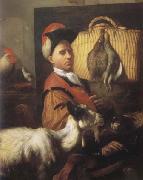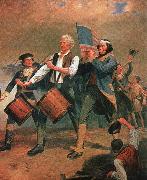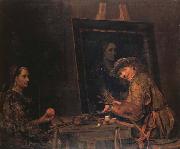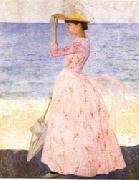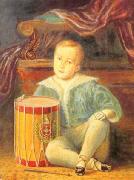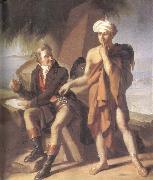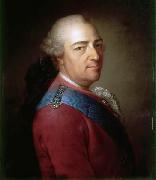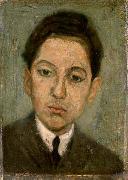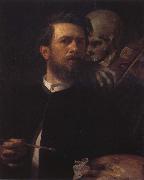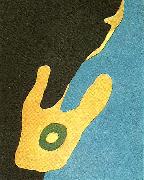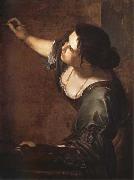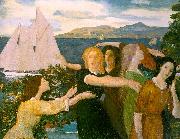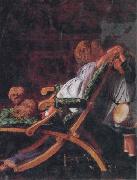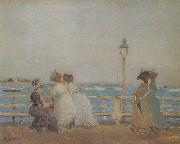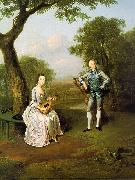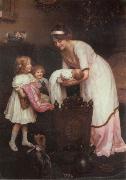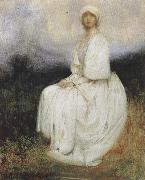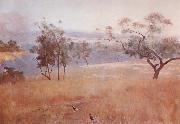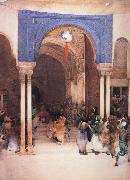|
|
|
|
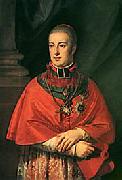 |
Archduke Rudolf of Austria
|
|
Rudolf Johannes Joseph Rainier von Habsburg-Lothringen, Archduke and Prince Imperial of Austria, Prince Royal of Hungary and Bohemia (8 January 1788 - 24 July 1831) was a Cardinal, an Archbishop of Olomouc, and a member of the House of Habsburg-Lorraine.
Born in Pisa, Italy, he was the youngest son of Emperor Leopold II and Maria Louisa of Spain. He was elected archbishop of Olomouc in 1819 and became cardinal in the year 1820.
In 1803 or 1804, Rudolf began taking lessons in piano and composition from Ludwig van Beethoven. The two became friends, and Rudolph became a supporter and patron of Beethoven; their meetings continued until 1824. Beethoven dedicated 14 compositions to Rudolph, including the Archduke Trio, the Hammerklavier Sonata, the Emperor Concerto and the Missa Solemnis. Rudolph, in turn, dedicated one of his own compositions to Beethoven. The letters Beethoven wrote to Rudolph are today kept at the Gesellschaft der Musikfreunde in Vienna.
On 24 March 1819 he was appointed, at the age of 31, Archbishop of Olomouc in the present day Czech Republic but then part of the Austrian Empire. He was made Cardinal-Priest of the titular church of S. Pietro in Montorio by Pope Pius VII on 4 June 1819. He was ordained a priest on 29 August 1819, and consecrated a bishop on 26 September.
In 1823 - 24, he was one of the 50 composers who composed a variation on a waltz by Anton Diabelli for Vaterländischer Kenstlerverein. In Rudolf's case, the music was published anonymously, as by "S.R.D" (standing for Serenissimus Rudolfus Dux).
|
|
|
|
|
|
|
|
|
|
|
|
 |
Arifi
|
|
The Sixteenth century Ottoman court poet
|
|
|
|
 |
aristotle
|
|
Born: 384 B.C.
Birthplace: Stagira, Greece
Died: 322 B.C.
Best Known As: The author of Ethics |
|
 |
Arkady Alexandrovich Rylov
|
|
Arkady Alexandrovich Rylov (Russian, 29 January [O.S. 17 January] 1870 - June 22, 1939) was a Russian and Soviet Symbolist painter.
Biography
Rylov was born in the village Istobenskoye, Vyatka gubernia. He was brought in the family of his stepfather, a notary (Rylov's father had a psychiatric illness). He moved to Saint Petersburg and studied at the Technical Design School of Baron Schtiglitz (1888-1891), then at the Imperial Academy of Arts under Arkhip Kuindzhi (1894-1897).
In the Blue Expanse, 1918Rylov was a member of the Mir iskusstva movement and its spin-off Union of Russian Artists also a member of the Association of Artists of the Revolutionary Russia. He was a chairman of the Kuindzhi Society. |
|
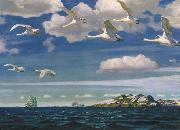 |
Arkady Rylov
|
|
(Russian: 29 January 1870 - June 22, 1939) was a Russian and Soviet Symbolist painter.
Rylov was born in the village Istobenskoye, Vyatka gubernia. He was brought in the family of his stepfather, a notary (Rylov's father had a psychiatric illness). He moved to Saint Petersburg and studied at the Technical Design School of Baron Schtiglitz (1888-1891), then at the Imperial Academy of Arts under Arkhip Kuindzhi (1894-1897).
Rylov was a member of the Mir iskusstva movement and its spin-off Union of Russian Artists also a member of the Association of Artists of the Revolutionary Russia. He was a chairman of the Kuindzhi Society.
He started as a historical painter (his graduation work in the Imperial Academy of Arts was Assault of Pechenegs on a Slav village but became a predominately landscape painter. Still many of his paintings have some allusions with Russian history.
Many of his landscapes painted after the October Revolution were seen as symbols of the revolutionary Freedom. At that time he also painted some typical Socialist Realism compositions like Lenin in Razliv. He taught in the Academy of Arts. In his studio he created almost a small nature reserve. There lived squirrels, rabbits, monkey Manka and many wild birds (without cages) and two anthills. According to Mikhail Nesterov wild animals and birds loved Rylov and often came to his studio.
|
|
|
|
 |
Arkhip Kuinji
|
|
was originally a Greek,Then he got to St. Petersburg1842 - 1910 |
|
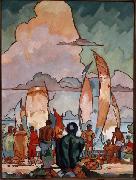 |
Arman Manookian
|
|
(1904 - 1931) was an Armenian-American painter. He was the oldest of three children born to a Christian Armenian family in Constantinople. As a teenager, he survived the Armenian Genocide. Manookian immigrated to the United States in 1920, at the age of 16, and studied illustration at the Rhode Island School of Design. He also took classes at the Art Students League of New York before enlisting in the United States Marine Corps in 1923. While serving in the U. S. Marine Corps he was assigned as a clerk to the author and historian, Major Edwin North McClellan. In 1925, McClellan and Manookian were transferred to Pearl Harbor. The latter supplied illustrations for Leatherneck Magazine and produced about 75 ink drawings for McClellanes history of the United States Marine Corps, which was never published. These drawings are now in the collection of the Honolulu Academy of Arts.
In 1927, Manookian was honorably discharged from the Marine Corps, but remained in Hawaii. He worked for the Honolulu Star-Bulletin and for Paradise of the Pacific.
His paintings are rare and highly valued due to his early death, by suicide, in 1931, and fewer than 30 are in existence. The Honolulu Academy of Arts held a memorial exhibition shortly after Manookianes death and a retrospective exhibition titled Meaning in Color/Expression in Line: Arman Manookianes Modernism Nov. 4, 2010 through April 24, 2011. The Bishop Museum and the Honolulu Academy of Arts are among the public collections holding works by Arman T. Manookian. According to the State of Hawaii's House of Representatives, he is "known as Hawaii's Van Gogh".
In early 2010 a group of seven Manookian paintings owned by the Hotel Hana-Maui were removed from public display. They were the only Manookian oil paintings known to be on public display anywhere in the world. Two of the murals, Red Sails and Hawaiian Boy and Girl, are now on long-term loan to the Honolulu Academy of Arts.
|
|
|
|
|
|
|
|
|
|
|
|
|
|
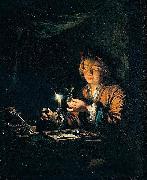 |
Arnold Boonen
|
|
Arnold van Boonen was a Dutch eminent portrait painter, was born at Dordrecht, in the Dutch Republic in 1669. He was first a scholar of Arnold Verbius, and was later instructed by Godefried Schalken. He painted genre pictures in the style of the latter, representing subjects by candlelight, but met with such encouragement in portrait painting that he devoted himself almost wholly to that branch of art. His style was well adapted to succeed in it. An excellent oolourist, a faithful designer of his model, and highly skilled, he was soon distinguished as one of the ablest artists of his day. He painted a great number of portraits of the most distinguished people of his time, among whom were Peter the Great, the Elector of Mentz, the Landgrave of Hesse-Darmstadt, the Prince and Princess of Orange, the great Duke of Marlborough, and several others. He painted some large pictures for the halls of the different companies at Amsterdam and Dordrecht. He died in 1729.
The Dresden Gallery has seven works by him, and the 'Woman Singing' in the Lille Gallery is also attributed to him. His son, Kasper van Boonen, also painted portraits, but in no way proved himself equal to his father.
|
|
|
|
|
|
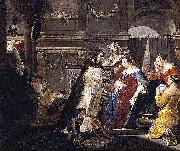 |
Arnold Houbraken
|
|
(28 March 1660 - 14 October 1719) was a Dutch painter and writer from Dordrecht, now remembered mainly as a biographer of artists from the Dutch Golden Age. He had ten children. His son Jacobus Houbraken (1698-1780) was an engraver of portraits and book illustrations, including books by his father. His daughter Antonina Houbraken also became an engraver for an Amsterdam publisher, and is known today for her embellishment of cityscapes and buildings with animals and people.
Houbraken was sent first to learn threadtwisting from Johannes de Haan, who introduced him to engraving. After two years he then studied art with Willem van Drielenburch, who he was with during the rampjaar, the year 1672. He then studied 9 months with Jacobus Leveck and finally, four years with Samuel van Hoogstraten. In 1685 he married Sara Sasbout, and around 1709 he moved from Dordrecht to Amsterdam. Arnold Houbraken painted mythological and religious paintings, portraits and landscapes. |
|
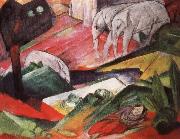 |
arnold schoenberg
|
|
Period: Modern (1910-1949)
Country: Austria/USA
Born: September 13, 1874 in Vienna, Austria
Died: July 13, 1951 in Los Angeles, CA
Genres: Band Music, Chamber Music, Choral Music, Concerto, Keyboard Music, Miscellaneous Music, Opera, Orchestral Music, Vocal Music
|
|
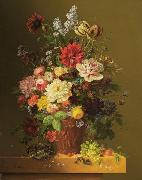 |
Arnoldus Bloemers
|
|
born at Amsterdam in 1792, painted flowers, fruit, and animals. He was instructed by Antonie Piera, but principally imitated Van Huijsum. He died at the Hague in 1844. The Rotterdam Gallery has a flower-piece by him.
|
|
|
|
|
|
|
|
|
|
|
|
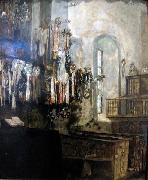 |
Arthur Ahnert
|
|
painted Interior of Wilhelmshausen church in 1898/1899.
|
|
|
|
|
|
|
|
|
|
|
|
|
|
|
|
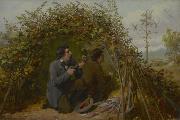 |
Arthur Fitzwilliam Tait
|
|
(February 5, 1819 -April 28, 1905) was an American artist who is known mostly for his paintings of wildlife. During most of his career, he was associated with the New York City art scene.
Tait was born in Lively Hall near Liverpool, England. At eight years old, because his father went bankrupt he was sent to live with relatives in Lancaster. It is during that time that he became attached to animals. Later on, in Manchester, England, Agnew & Zanetti Repository of Art acquired Arthur Tait who began self-learning to paint, as a twelve-year-old boy. |
|
|
|
|
|
|
|
|
|
|
|
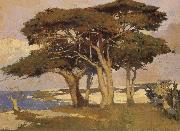 |
Arthur Mathews
|
|
an American Tonalist painter who was one of the founders of the American Arts and Crafts movement
1860-1945
|
|
|
|
|
|
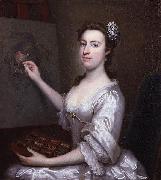 |
Arthur Pond
|
|
Arthur Pond (1705?-1758) was an English painter and engraver.
Born about 1705, was educated in London, and stayed for a time in Rome studying art, in company with the sculptor Roubiliac. He became a successful portrait-painter.
He was elected a Fellow of the Royal Society in 1752, and died in Great Queen Street, Lincoln's Inn Fields, 9 September 1758.
His numerous original portraits include Alexander Pope, William, Duke of Cumberland, and Peg Woffington. Pond was also a prolific etcher, and used various mixed processes of engraving by means of which he imitated or reproduced the works of masters such as Rembrandt, Raphael, Salvator Rosa, Parmigiano, Caravaggio, and the Poussins.
In 1734-5 he published a series of his plates under the title Imitations of the Italian Masters. He also collaborated with George Knapton in the publication of the Heads of Illustrious Persons, after Jacobus Houbraken and George Vertue, with lives by Thomas Birch (London, 1743-52); and engraved sixty-eight plates for a collection of ninety-five reproductions from drawings by famous masters, in which Knapton was again his colleague. Another of his productions was a series of twenty-five caricatures after Pier Leone Ghezzi, republished in 1823 and 1832 as Eccentric Characters.
|
|







